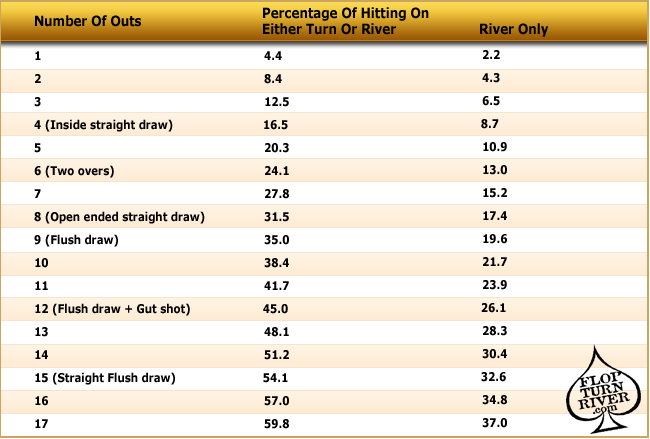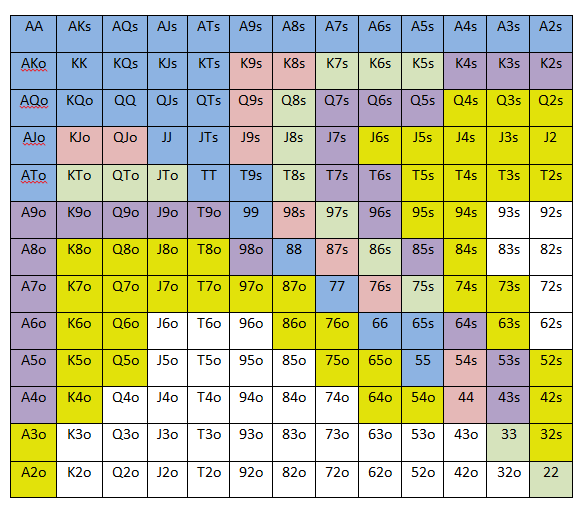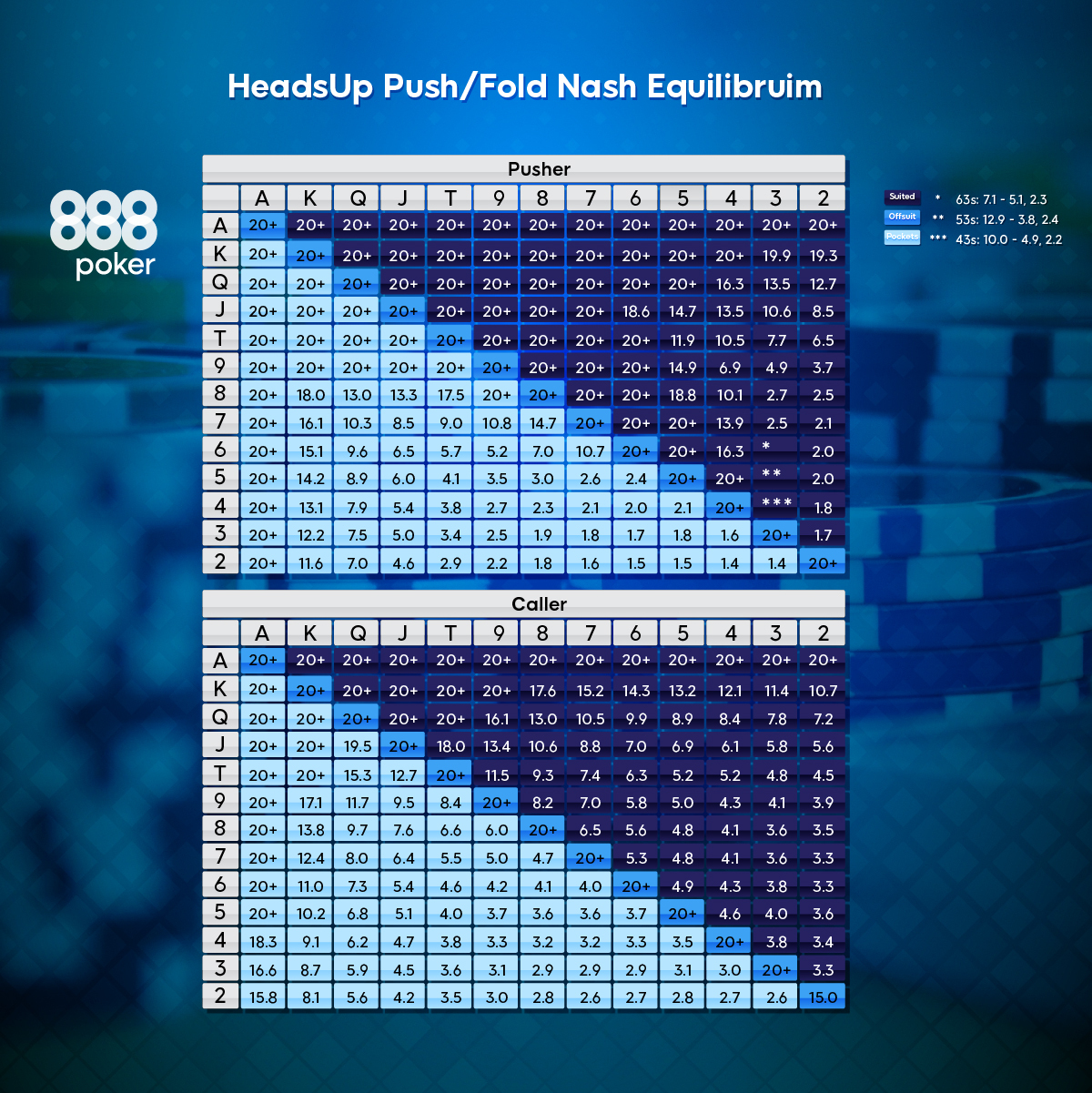PokerSpoils Newsletter
Enter your email address below so I can send you exclusive promotions that I am not allowed to advertise on this website!
Popular Pages
A Guide to Texas Hold'em Poker Please note that this is not a full guide to playing Texas Hold'em but covers just enough that you won't be baffled. Here's how it's played: 1. The two players to the left of the dealer put out blind bets (see below). Wising up when you enter a poker game means knowing your stuff. That includes everything from knowing the rules of poker games, knowing the forms of poker you prefer to play, and knowing, for.
Poker Rooms Reviewed
-PokerStars
-Bovada Poker
-Cake Poker
-Party Poker
-PKR Poker
-Titan Poker
Poker Bonuses
-PokerStars Bonus
-Bovada Poker Bonus
-Cake Poker Bonus
-Party Poker Bonus
-PKR Poker Bonus
Learning how to count your outs and calculate your chances of winning the pot are two of the most important skills winning poker players possess. The whole process sounds a lot harder than it actually is but it does take a little study to get the hang of it. Once you do, however, your outs and odds calculations will come without thought. Paragon casino jobs in marksville la.
Outs Explained

'Out' is simply a term used to describe any yet-to-come card that will win the hand for you. For example, if you have a diamond flush draw, any diamond remaining in the deck would be considered an out. Because there are 13 cards of each suit in the deck and you have seen four of them already (2 in your hand and two on the board), you would have 9 outs in this example.
Another example would be if you had two pair but think your opponent has a better hand. You have 4 outs to win the hand because there are 4 cards left in the deck that could improve your two pair to a full house.
Counting Your Outs
All your calculations are useless if you don't count your outs correctly. Don't worry about what may or may not be in your opponents' hands; just count your outs as if it's just you and the deck.
The most common draws are pretty straightforward. Flushes have 9 outs, open-ended straight draws have 8 outs and inside straight draws have 4 outs. Other draws are harder to count because you might not know for sure what cards you need to win your hand. These include draws like improving from one pair to two pair, two pair to full house, and so on.

With those less-defined types of draws, the weaker your opponent's hand, the more outs you have. Say you have AK and missed the flop but you think your opponent only has a low pair. You would have 6 outs - 3 aces and 3 kings - to beat your opponent.
Counterfeit Outs
Counterfeit outs are outs that don't actually help your hand - in fact they're quite dangerous. For example, let's say you are still on that flush draw but your opponent has a set. You need to discount any flush cards that pair the board because those cards would give your opponent a full house. Counterfeit outs can give you very expensive second-best hands so make sure you never forget to discount these from your outs total.
Calculating the Odds of Catching an Out
There are two ways to calculate the chances of you catching an out. One method involves a big, nasty equation and the other method is simple but not as accurate. Long equations are useless at the poker table so we'll cover the simple method here.

After you know how many outs you have, multiply that number by 4 to get your approximate chance of hitting that card on either of the next two streets. With a flush draw, you multiply your 9 outs by 4 to get 36%. This is close enough and simple enough to be useful at the tables.
If you're on the turn and only have one card to go, multiply your outs by 2 to find the percentage of chance you have. With a flush draw, you would take 9 times 2 to get an 18% chance to hit on the next card.
Poker Concepts Worth Knowing
In Omaha Poker not all ‘outs' (card which can improve your hand) are equal – that is to say that the combinations of hands your opponents may hold can easily mean that a card which makes your hand could make an opponent an even better one.

'Out' is simply a term used to describe any yet-to-come card that will win the hand for you. For example, if you have a diamond flush draw, any diamond remaining in the deck would be considered an out. Because there are 13 cards of each suit in the deck and you have seen four of them already (2 in your hand and two on the board), you would have 9 outs in this example.
Another example would be if you had two pair but think your opponent has a better hand. You have 4 outs to win the hand because there are 4 cards left in the deck that could improve your two pair to a full house.
Counting Your Outs
All your calculations are useless if you don't count your outs correctly. Don't worry about what may or may not be in your opponents' hands; just count your outs as if it's just you and the deck.
The most common draws are pretty straightforward. Flushes have 9 outs, open-ended straight draws have 8 outs and inside straight draws have 4 outs. Other draws are harder to count because you might not know for sure what cards you need to win your hand. These include draws like improving from one pair to two pair, two pair to full house, and so on.
With those less-defined types of draws, the weaker your opponent's hand, the more outs you have. Say you have AK and missed the flop but you think your opponent only has a low pair. You would have 6 outs - 3 aces and 3 kings - to beat your opponent.
Counterfeit Outs
Counterfeit outs are outs that don't actually help your hand - in fact they're quite dangerous. For example, let's say you are still on that flush draw but your opponent has a set. You need to discount any flush cards that pair the board because those cards would give your opponent a full house. Counterfeit outs can give you very expensive second-best hands so make sure you never forget to discount these from your outs total.
Calculating the Odds of Catching an Out
There are two ways to calculate the chances of you catching an out. One method involves a big, nasty equation and the other method is simple but not as accurate. Long equations are useless at the poker table so we'll cover the simple method here.
After you know how many outs you have, multiply that number by 4 to get your approximate chance of hitting that card on either of the next two streets. With a flush draw, you multiply your 9 outs by 4 to get 36%. This is close enough and simple enough to be useful at the tables.
If you're on the turn and only have one card to go, multiply your outs by 2 to find the percentage of chance you have. With a flush draw, you would take 9 times 2 to get an 18% chance to hit on the next card.
Poker Concepts Worth Knowing
In Omaha Poker not all ‘outs' (card which can improve your hand) are equal – that is to say that the combinations of hands your opponents may hold can easily mean that a card which makes your hand could make an opponent an even better one.
The key factor in Omaha is to quickly assess whether an out will give you the best hand, a card which does this is known as a ‘nut out'. If this card comes on the turn you may not be in the clear just yet! If it is possible that a river card could allow an opponent to made an even better hand then you could still lose (the most common example is when the river pairs the board – giving an opponent a full house against your nut flush).
An out which makes you the best hand on the turn regardless of what comes on the river is known as a ‘killer out'. The most common examples would be cards that make you a straight flush or quads.
Here we will look at some examples of Omaha Poker hands on the flop and discuss the type of outs which each hand has. We will include the number of cards which might come on the river to counterfeit your hand in each example.
Your Hand: 4-5-6-8 (4 suits)
The Flop: 2-3-K (unsuited)
Here you have a monster draw – any ace, 4, 5, 6 on the turn will give you the nut straight, giving you a total of ‘nut' 13 outs on the turn. Since the board is unsuited you do not need to worry about flushes, the only cards here that could ruin your hand are those which pair the board – potentially giving an opponent a full house. A 6 or 7 may not be as good a card as this seems on the turn here – now an opponent holding 4-5-7-9 or 4-5-6-9 will have a free chance to our draw you on the river.
Your Hand: A-A-K-J (double suited)
The Flop: A-4-9 (2 of your suit)
This is the best possible scenario in Omaha – you have flopped the monster holding of top set + the nut flush draw. Here you have 6 outs for a full house on the turn in addition to 1 ‘killer out' of the remaining ace). In addition any of the remaining cards of your suit will give you the nut flush, since 2 cards are already suited to your hand we need to remove the remaining suited card to avoid double counting. This leaves you 8 more nut outs for a total of 15 – not bad in the situation where you have the current nut hand. The danger on this board is that you are facing an opponent with a low straight draw such as 2-3-5-6, in the event that this opponent hits a 5, 3 or 2 on the turn you would have an additional 3 full house outs on the river, and this is assuming that you did not make your flush at the same time your opponent hit their low straight!
The only (unlikely) scenario in which you may loose your hand is where an opponent holds trip 4's or 9's and makes quads on the turn or river. It is also feasible that unsuited cards
Poker Outs Explained Games
Your Hand: K-K-6-7 (unsuited with 6 of hearts)
The Flop: Q-J-9 (2 hearts)
Poker Outs Explained Poker
Here you flopped an over pair to the board, however your hand is extremely vulnerable and will usually need to be mucked to serious action. The problem here is that there are either made hands containing 8-10 or 10-K already against you – or your opponents have such a large number of potential draws as to make them favorite in the hand. We should also note that you outs are not to the nuts. If you hit one of the remaining Kings on the turn you are in even more danger… one of them is a heart completing likely flushes and this card also allows any A-10 hands to make the nut straight. Hitting the king on the turn gives you a 10 out redraw to a full house or quads – however we strongly advise you to avoid getting into this situation by folding to any action on the flop!
Poker Outs Explained Game
Of course, holding kings here makes it more difficult to opponents to draw to straights – the cards you hold are ‘blocking' your opponent's outs to some extent. Check out our article on Blockers In Omaha Poker for more information how to play these type of situations.
Poker Outs Explained Rules
Not all poker sites are equal when it comes to the fixed limit Omaha Poker games – as you will see in our guides to the best Omaha Poker sites. When it comes to the Fixed Limit Betting, 888Poker.com is a clear leader. They have more cash games at more buy-ins than any other site, and a great range of sit N goes, tournaments and mixed poker games too. On top of this, you will find excellent software and what is considered to be the very best player loyalty scheme around. Check out 888Poker.com now